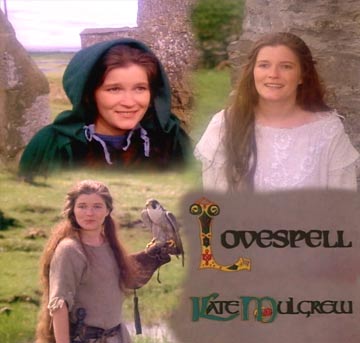Filmed in 1979 Clar Productions Presents a Castle Hill Productions, Inc. Release in Association with Paul Avila Mayer Producers - Tom Hayes, Claire Labine Executive Producer - Thomas H. Ryan Written by - Claire Labine Directed by - Tom Donovan Music - Paddy Moloney; Performed by The Chieftans Photography - Richard H. Kline Filmed entirely on location in Ireland

On the voyage, Tristan and Isolt are overwhelmed by an insane passion and make love. Isolt gives Tristan a Druid potion, binding him to her eternally. Arriving in Cornwall, Isolt proceeds with the marriage to Mark. Tristan resolves to do nothing further disloyal to his King, and mentor, and best friend Mark, the husband of his beloved. The impetuous Isolt insists on seeing Tristan and, once discovered, the lovers are forcibly torn apart with Tristan exiled while Isolt becomes a prisoner of the castle. However, the lovers have become bound together
forever by the Durid potion. Their fate unfolds in a series of enigmatic
events which reunite them at last, if only in death.
Excerpt from: Cinema Arthuriana: Twenty Essays Edited by Kevin J. Harty Filming the Tristan Myth by Meradith T. McMunn Lovespell (1979), alternately titled Tristan and Isolt, directed by Tom Donovan, is also relatively faithful to the medieval legend. Filmed in color in Ireland, it emphasizes the Celtic cultural setting of the legend by its score, which uses Irish folk music, its titles, based on the Book of Kells, and even Isolt's hawk, which is named for the medieval Irish hero Cuchulain. The script also contains frequent references to Irish history and folklore. Rich colors mark sets and costumes, and scenes are often shot in bright sunlight rather than in the chiaroscuro favored by other Tristan directors. Kate Mulgrew is cast as Isolt. She matches Richard Burton's Mark in appealing assertiveness and willful intensity. Perhaps in part because of the dynamism of the actors, these two characters dominate the film, shifting the balance away from Tristan (Nicholas Clay). The film's title could well have been "Mark and Isolt." Lovespell opens with their meeting in the fields near Isolt's home where she hunts alone with her tercel. Mark orders his companion knight to get the tercel from the unknown girl who "must have stolen it." Her response is a blow with a grouse, which knocks the knight into the nearby stream. The incident may have been suggested by a historical event during the Third Crusade, when Richard the Lionhearted, riding through Calabria with only a single attendent, "rescued" a falcon from a peasant's hut and was chased by the villagers (Runciman 38). Throughout the film, the struggle for control between Mark and Isolt is sometimes friendly but increasingly bitter. She becomes an abused wife, first emotionally and then physically. The once assertive Isolt turns withdrawn and passive. In the final sequence, Mark brings the mortally wounded Tristan by ship back to Cornwall for the sake of Isolt who is now dying of grief because of his absence. In a reversal of the tradional story, it is Isolt who receives the news that the sails of the ship are white, signifying Tristan's return. As they approach land, Tristan affirms his liaison with the queen, and, in a jealous rage, Mark changes the sails to black, the sign that Tristan is not on board, From the top of the high cliffs, Isolt sees the black sails and falls to her death on the rocks below. Tristan jumps from the ship and swims to shore, but the effort exhausts his remaining strength, though the lovers manage to touch hands as they die on the rocky beach. The final shot of the film is of Mark alone, dressed in red and dominating the visual space, surrounded by the turbulent waves. |
|||||||||||||||||||||||||||

